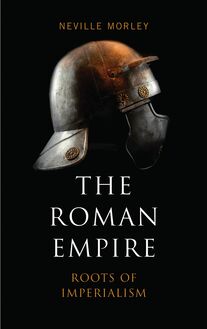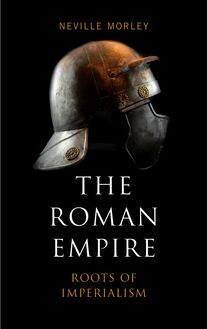The Roman Empire , livre ebook
112
pages
English
Ebooks
2010
Vous pourrez modifier la taille du texte de cet ouvrage
Obtenez un accès à la bibliothèque pour le consulter en ligne En savoir plus
Découvre YouScribe en t'inscrivant gratuitement
Découvre YouScribe en t'inscrivant gratuitement
112
pages
English
Ebooks
2010
Vous pourrez modifier la taille du texte de cet ouvrage
Obtenez un accès à la bibliothèque pour le consulter en ligne En savoir plus
Publié par
Date de parution
04 juin 2010
Nombre de lectures
5
EAN13
9781783715732
Langue
English
Poids de l'ouvrage
1 Mo
The idea of Rome has long outlived the physical empire that gave it form, and now holds sway over vastly more people and a far greater geographical area than the Romans ever ruled. It continues to shape our understanding of the nature of imperialism and influence the workings of the world. It is through the lens of Rome that we answer questions such as: How do empires grow? How are empires ruled? Do empires exploit their subjects or civilise them? Rejecting the simplistic narrative of military triumph followed by decline and fall, the books analyses the origins of Roman imperialism, its wide-ranging impact on the regions it conquered, and its continuing influence in debates about modern imperialism.
Acknowledgements
Introduction: ‘Empire Without End’
1. ‘Carthage Must Be Destroyed’: The Dynamics of Roman Imperialism
2. ‘They Make a Desert and Call It Peace’: The Nature of Roman Rule
3. ‘The Emporium of the World’: The Economic Impact of Empire
4. ‘They Called it “Civilisation”’: The Dynamics of Cultural Change
Envoi: ‘Decline and Fall’
Further Reading
Index
Publié par
Date de parution
04 juin 2010
Nombre de lectures
5
EAN13
9781783715732
Langue
English
Poids de l'ouvrage
1 Mo
The Roman Empire
Roots of Imperialism
Series Editors Reinhard Bernbeck and Susan Pollock, Berlin/Binghamton
This series highlights the relevance of past empires for our contemporary world. It is concerned primarily with the political nature of connections between the past and the present. The approach is radical in that it directs the reader to a recognition of how past empires are theoretically and practically entangled in contemporary imperialist and economically exploitative endeavors.
The series sets itself apart from other books on past empires by including the point of view of dependent populations and victims of imperialism, rather than focusing solely on their beneficiaries, the well-known kings and imperators and their material surroundings of monuments and gold. Accordingly, the books devote attention to actions taken by dependent populations in response to imperial politics by giving a historical voice to resistance, subversion, and evasion.
The books also investigate the ways in which past empires survive – or, in some instances, are silenced – in present conditions. Residues of the past serve political ideologies in often hidden ways, making them all the more powerful because they are taken for granted. The books reveal imperialist, nationalist, neocolonialist or economic goals of powerholders today who mobilize past imperial figures and structures as well as their material remains to support their own agendas.
THE ROMAN EMPIRE
Roots of Imperialism
Neville Morley
First published 2010 by Pluto Press 345 Archway Road, London N6 5AA and 175 Fifth Avenue, New York, NY 10010
www.plutobooks.com
Distributed in the United States of America exclusively by Palgrave Macmillan, a division of St. Martin’s Press LLC, 175 Fifth Avenue, New York, NY 10010
Copyright © Neville Morley 2010
The right of Neville Morley to be identified as the author of this work has been asserted by him in accordance with the Copyright, Designs and Patents Act 1988.
British Library Cataloguing in Publication Data A catalogue record for this book is available from the British Library
ISBN 978 0 7453 2870 6 Hardback ISBN 978 0 7453 2869 0 Paperback ISBN 978 1 7837 1573 2 ePub ISBN 978 1 7837 1574 9 Mobi
Library of Congress Cataloging in Publication Data applied for
This book is printed on paper suitable for recycling and made from fully managed and sustained forest sources. Logging, pulping and manufacturing processes are expected to conform to the environmental standards of the country of origin.
10 9 8 7 6 5 4 3 2 1
Designed and produced for Pluto Press by Chase Publishing Services Ltd, 33 Livonia Road, Sidmouth, EX10 9JB, England Typeset from disk by Stanford DTP Services, Northampton, England Printed and bound in the European Union by CPI Antony Rowe, Chippenham and Eastbourne
For Hugh
Contents Acknowledgements Timeline
Introduction: ‘Empire Without End’ 1 ‘Carthage Must Be Destroyed’: The Dynamics of Roman Imperialism 2 ‘They Make a Desert and Call it Peace’: The Nature of Roman Rule 3 ‘The Emporium of the World’: The Economic Impact of Empire 4 ‘They Called it “Civilisation”’: The Dynamics of Cultural Change Envoi: ‘Decline and Fall’
Further Reading Notes Index
Acknowledgements
This book is dedicated to the memory of my uncle, Hugh Chapman, who as an archaeologist and museum curator first inspired my interest in the messy and fragmentary reality of the past, rather than its polished and misleading representation. I have no idea what he might have made of my take on the subject; this is an inadequate substitute for all the conversations that we might have had.
As ever, my greatest debt of gratitude is to Anne, for putting up once again with the agonies of book-writing and for helping to pull me through them. I have as always been inspired by the ideas of numerous colleagues, both through conversation and through their publications, and particularly wish to mention Sue Alcock, Richard Alston, Clifford Ando, Catharine Edwards, David Grewal, Richard Hingley, Martin Jehne, David Mattingly, Jörg Rüpke, Nic Terrenato, Tim Whitmarsh and Greg Woolf. I am grateful to the University of Bristol for a year’s research leave in which to complete the work and to recover from eight years’ worth of faculty administration, to Gillian Clark for moral support, and to everyone on the ’Spill for providing a regular distraction.
Timeline
BCE 754/753: Traditional date of the foundation of Rome 509: Expulsion of the kings and foundation of the Republic 395: The neighbouring city of Veii is captured 390: Rome is sacked by the Gauls 341, 340–337, 327–304, 298–290: Wars against the Samnites and other Italian tribes 312: Construction of the Via Appia from Rome to Capua 280–272: War against Tarentum and the Greek king Pyrrhus 264–241: First Punic War 227: Sicily, Corsica and Sardinia established as Roman provinces 219–202: Second Punic War 215–205: First Macedonian War 200–196: Second Macedonian War 197: Spain becomes a Roman province 192–188: War against Antiochus of Syria 172–168: Third Macedonian War 149–146: Third Punic War 146: War against the Achaean League; Macedonia and Africa established as provinces 120/119: New province of Gallia Narbonensis 91–88: A significant number of the Italian allies revolt; the Social War 73–71: War against Spartacus’ slave revolt 58–50: Caesar’s campaigns in Gaul 49: Caesar crosses the Rubicon; defeats Pompey at Pharsalus in 48 44: Assassination of Caesar 31: Octavian defeats Antony and Cleopatra at Actium 27: Octavian becomes Augustus
CE 9: Three legions ambushed and slaughtered in Germany 14: Death of Augustus 43: Claudius invades Britain 61: Revolt of Boudicca 66–70: Jewish revolt and subsequent war 115–17: Second Jewish revolt 122: Construction of Hadrian’s Wall 167: The Antonine Plague sweeps the empire 284–305: Diocletian restores order after 50 years of political upheaval, and divides the empire in two 312: Constantine seizes power in the west and declares his support of Christianity 361–63: Pagan revival under Julian is cut short by his death 378: A Roman army is defeated at Adrianople by the Goths 395: Empire permanently divided after the death of Theodosius 410: Sack of Rome by Alaric the Goth 439: Carthage seized by the Vandals 476: The last emperor in the west, Romulus Augustulus, is deposed
Introduction: ‘Empire Without End’
I place no limits on them of time or space; I have given them power without boundaries.
(Virgil, Aeneid , I.278–9)
A millennium and a half after the end of the period of its unquestioned dominance, Rome remains a significant presence in Western culture. This is not only a matter of its continuing popularity as a setting for pseudo-historical drama in film and television, an exotic world of well-oiled gladiators, decadent emperors, seductive priestesses and political intrigue tempered with violence. 1 Since the Renaissance, Rome has had a prominent role in intellectual developments, in debates about the organisation of the state and the conduct of its foreign policy and about the nature and morality of encounters between Europe and the rest of the world. 2 Rome is seen as the greatest civilisation of the past, with a direct genetic and historical connection to Europe and the West, and hence stands as both an inspiration and a challenge to modernity. Even as the nineteenth century congratulated itself on its unprecedented material power – as Karl Marx put it in the Communist Manifesto , ‘[the modern bourgeoisie] has accomplished marvels wholly different from Egyptian pyramids, Roman aqueducts and Gothic cathedrals’ – it was haunted by two fears: that in other respects it might have failed to match its ancient rival, and that it would prove no more able to escape the corrupting effects of time and success than Rome had done. 3 Modernity defined itself against antiquity, drawing on the tradition of engagement with its literature and history and on the idea of Rome developed in art and literature over the centuries, and measured its achievements against those past glories.
THE EXEMPLARY EMPIRE
In these debates Rome was understood in different ways, depending on what sort of comparison or contrast with the present was intended: discussions of political structures, such as Machiavelli’s The Prince or the debates around the United States constitution, considered Rome as a state, while advocates of a European or Western identity saw it as a civilisation. Most often, it was seen as an empire; indeed, as the archetypal empire, the epitome and supreme expression of imperial power. Later European empires sought to emphasise their connection to Rome, as a means of establishing their historical status and legitimising their dominance of others, and also derided the claims of other states, such as Byzantium. 4 The wish to claim a special relationship with the Roman Empire recurs time and again, from the insistence of the Carolingian kings on being styled ‘emperor and Augustus’ to the public pronouncements of the Holy Roman Empire, from the French and British empires of the nineteenth century to the Fascist and Nazi projects of the twentieth century. 5 Modern empires drew on Rome above all for their iconography, finding there the art and architecture considered appropriate to reflect and magnify imperial power. In capital cities such as Paris and London, in the government buildings designed by Lutyens in New Delhi and in the triumphal arches that are found in places that were never Roman settlements, such as Munich, or never even part of the Roman Empire, such as Berlin, the use of classical templates and styles both imitated the Roman deployment of monumental architecture as a means of domination and asserted a claim to be their rightful heirs. 6
As well as providing the template for how an empire ought to present itself, Rome was central to modern debates about the nature, dynamics and morality of imperialism. Its status as an empire was beyond question; however ‘e

